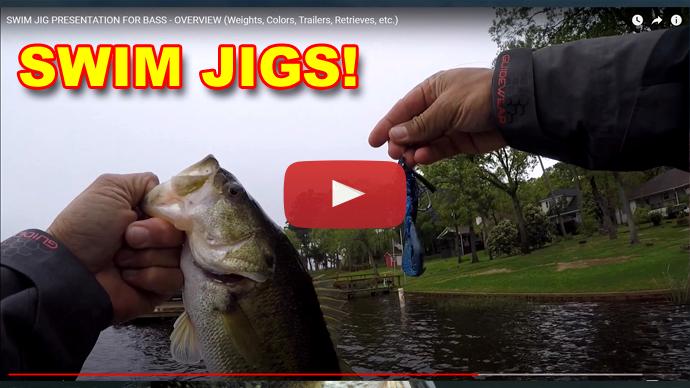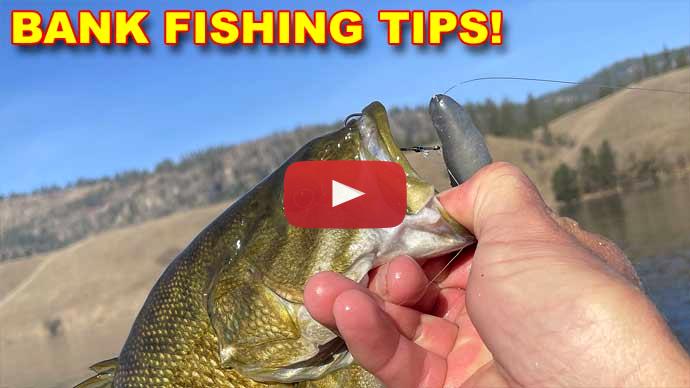Hey guys, Wes Logan here with BassResource. Gonna be doing something a little bit different today. We are sitting in a boat but we're gonna be talking about swim jig fishing from the bank. You know, not everybody's got a boat or maybe you want to go to your local pond or you've got a really good private pond that doesn't have boats in it and you want to find a way to catch, you know, one of the really biggest bass in that pond, a swim jig is a great way to do it, but you kind of have to approach it a little bit different than you would be in a boat, obviously, because you're gonna be throwing the opposite way than you would be from a boat. With a boat, you're gonna be throwing towards the bank. If you're on the bank, you're gonna be throwing out into the lake. But there's a few little key things that you can do to help your odds in catching a few fish from the bank with a swim jig.
First off is just gonna be the jig itself. And, you know, I don't think the jig's gonna change a lot from what I would use if I was on a boat. I'm gonna be throwing either a 1/4-ounce regular Dirty Jigs Swim Jig or the Dirty Jigs 5/16 No-Jack, and that's kind of just depending on what caliber of fish I think is in the lake or the pond that you're fishing. If you're fishing a pond or a lake that, you know, the biggest fish may be 3 pounds, you know, I'm probably just gonna go with the 1/4 with the regular hook because I think you're gonna be kind of overpowering with that No-Jack.
On the vice versa side of that if you're in a lake or if you're fishing down the bank at Lake Fork where there's 12-pounders swimming around, you probably need to be throwing that Dirty Jigs around or the Dirty Jigs No-Jack...excuse me, because it's just got that beefier hook. It's gonna have a lot better landing percentage if you happen to hook into one of those 6, 7, you know 9, 10 pound, or something like that. So that would be the difference in the jig sizes that I would use.
Color-wise, it really depends on what the main forage is in your lake because I feel like with you fishing from the bank, you're gonna be dealing with a lot of probably bluegill, some type of sunfish, and a crawfish. Depending on the time of year, if you're in the fall, you may be dealing with a lot more shad. So just depending on the time of year and what the main forage is, is what you would kind of determine what color you want to throw, but it's hard to beat a white shad color, a black and blue, something like that, or a natural.
I mean, that's the three main colors that I keep in my boat at all times. You don't really have to get too fancy with that but just those three different hue of colors is kind of...if you were going to take a tackle box to the lake, I would have those three colors in it. And then with that from a trailer standpoint, the color, I would just have the color options to fit those color swim jigs. So a dark one, a white pearl one or in a natural green, pumpkin, watermelon, something like that.
For trailer style, I would probably just keep it the same I do on a boat, which is gonna be the Zoom Super Speed Craw, the Zoom Ultravibe Speed Craw, or the Zoom Z-Craw Jr. And mainly, all these are gonna be, you know, your craw-type trailers, the flap, and the action, all of that good stuff.
Because most of the time when a bass is on the bank, which is what we're gonna be fishing down, he's up there to eat. He mainly doesn't live on the bank, whether he be in a pond or a bigger lake, or anything like that. If he's up there on the bank, he's ready to eat. So I feel like you need a little bit more action to give yourself a better opportunity to catch that fish on a swim jig off the bank.
Moving into the rod and reel setup. I would say that being on the bank is gonna be a little bit different from the boat for the reason of rod length because most of the time if you're on the bank, you're gonna be dealing with overhanging limbs. You're not gonna have a great platform of nothing around you to throw. Sometimes you may be throwing over bushes on the bank. You know, you can't stand actually in the water, sometimes you could but not all the time. So you're probably gonna be throwing around something the majority of the time. I would probably lean more towards a 7' 3" medium heavy.
If you wanted to try a 7-foot medium-heavy, that would be good. But the main thing with the rod is that shorter length and then that medium-heavy, that heavy action is really key with the swim jig. You've got to have the good parabolic bend. You don't want to be ripping that jig out of the fish's mouth before he gets it good. Because most of the time the way I fish it, the way I would be fishing a swim jig down the bank would be I'd be looking at the jig, you know, 95% of the time coming back to me.
So I'm gonna see that fish get the bait. If I've got a heavy rod, you know, with no bend, I may jerk it away from him too quick. And if the fish does happen to get the bait and I jerk too hard with that heavy, you could flex the hook on this 1/4-ounce regular swim jig, so you gotta be careful with that.
But, you know, the 7-foot to 7' 3" medium heavy is just gonna give you that shorter rod to be able to work your bait around certain things, make some good casting with overhanging limbs, or if you're wanting to throw it under a tree or something like that.
Line, I'm gonna stick with the, you know, obviously, the bigger braids, the 40 to 50 on the 1/4-ounce, and then I'll keep the 60-pound Sunline FX2 Frogging & Flipping on the No-Jack. The 40-pound's gonna be SX1 Sunline. It's a little bit smaller diameter. It casts very well. It makes that 40-pound... lets this 1/4-ounce swim jig have a lot of, you know, action. It's not overbearing like the 60 would be on this lighter swim jig.
But again, I feel like fishing from the bank is tough in itself but if you put the odds in your favor with throwing a big fish bait and there is a few big fish in the lake or pond that you're fishing, there's no reason that you can't catch one of these off the...one of those bigger fish off the bank if you throw these swim jigs and the right trailer with the right retrieve.
And going into that retrieve, you know, so from a cast angle standpoint, let's say you're standing on the bank looking out into the main lake or the bigger part of the pond, wherever you're at, you're gonna have the bank on your right and the bank on your left. I'm gonna be throwing...making an angle cast out into the middle but probably only, you know, 20 to 30 feet, at the most, off the bank, and then I'm gonna be bringing it back at an angle towards the bank.
So it's gonna give that, you know, when you're working a swim jig, a natural look of a baitfish or whatever, bluegill, swimming down the edge of the bank. It's gonna let you cover a lot of water in the strike zone for where those fish are gonna be setting up on the edge of the bank. Just like if you were throwing it from the boat, it's just an opposite direction basically all it is.
And all you're gonna do is I'm gonna make that angle cast be bringing it back towards me on the bank, bringing it through the strike zone, gonna be having the bait way up in the water calm where I can see it.
If I notice some fish are following it or short striking or something, I'll change up my retrieve. You know, I'll shake it a little more. I might slow it down. I might speed it up. I might let it sink a little bit. I might let it, you know, get it going real good and then kill it. Just trying to figure out what the fish wants you to do.
And really, it just...I feel like the main thing with that bank deal is the angle of the cast and just making it look as natural as possible. Because if you're standing on the bank and you throw straight out into the lake every time, like, straight out into where it's deep, you're only gonna be in that strike zone, that fish being on the bank for, like, 5 feet.
So when you angle that cast down, either way, you're gonna be staying in that strike zone for the majority of your cast instead of just a small window, which is gonna increase your odds of getting a bite, you know, at some point in time.
So with all that being said, I feel like, you know, the swim...I've said it, you know, 100 times, swim jig catches big ones. If there's big ones in your lake and you're fishing from the bank, don't be afraid to pick it up and throw it. You might be really surprised what you catch. Good luck guys and see you next time.



